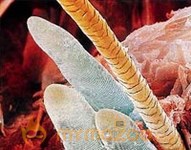Scalp pimples or scalp acne are not always the same as garden-variety skin pimples. The scalp is, of course, skin, but scalp pimples usually involve the hair follicles, which get inflamed. The disorder can vary in nature and comes under various scientific names, but basically they all result in small, itchy pustules that are usually first noticed while combing or brushing of hair. Such pimples get infected in no time at all and become a major problem.
The cause of scalp pimples is not clear. In certain cases, micro-organisms such as yeast, mites and the dreaded staph bacterium that often thrive in the uniquely suitable host environment of the scalp can lead to scalp pimples. In such cases, treatment with topical antibiotics such as clindamycin or erythromycin solutions or oral tetracycline may be necessary. In more severe infestations, even steroids may be needed. In milder cases, simple but unrelenting scalp hygiene can resolve the problem.
The milder forms of scalp pimples are a nuisance but nothing to worry about. The affected area may respond to the application of a salicylic acid solution or other over-the-counter pimple preparations. There is, however, one drawback: the extreme dehydrating and stripping action of compounds like benzoyl peroxide can have very adverse and permanent effects on the actual hair. At the very least, an unsightly bleaching may take place; at worst one may lose hair. For this reason, the application of pimple-control treatment solutions should be strictly limited to the affected areas.
Routine scalp hygiene should be improved if scalp pimples become evident. A good hypoallergenic shampoo calibrated for oily skin types will definitely be of benefit, since it will limit the occurrence of sebum. Local pimple-control applications will be of maximum efficacy after thorough shampooing.











